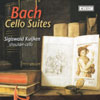Bach, JS Cello Suites (on Violoncello da Spalla)
The Cello Suites as you’ve never heard them before – but you really should
View record and artist detailsRecord and Artist Details
Composer or Director: Johann Sebastian Bach
Genre:
Instrumental
Label: Accent
Magazine Review Date: 9/2009
Media Format: CD or Download
Media Runtime: 0
Catalogue Number: ACC24196

Tracks:
| Composition | Artist Credit |
|---|---|
| (6) Suites (Sonatas) for Cello |
Johann Sebastian Bach, Composer
Johann Sebastian Bach, Composer Sigiswald Kuijken, Violoncello da spalla |
Author: Lindsay Kemp
The sound, perhaps not surprisingly, sits somewhere between those of the cello and the viola, achieving a happy combination of the former’s depth of tone and the latter’s melodic lucidity. But there are other advantages: in Kuijken’s violinist’s hands a lithe, running smoothness of line is possible, shown to good effect in the Bourrée of Suite No 3, the Gigue of No 4 or the Courante of No 6. Indeed, Suite No 6 emerges as quite a beauty, with the spalla’s reduced bass resonance really cleaning up the texture of the Prelude, and the high-lying top lines singing out with silvery voice.
Against these advantages, an occasional technical awkwardness (shown, for example, in the Prélude of No 4) is but a small concern. Kuijken’s own musicianship is also a major plus. There must be few players who start their relationship with these wonderful pieces so late in life, and there is much wisdom and fine Baroque sensibility on show here; Kuijken’s secure momentum and gentle grasp of the music’s dance rhythms are something any player could learn from. However much it may look like an eccentric experiment, this questing release from one of the great figures of the period revival is one of major interest.
Discover the world's largest classical music catalogue with Presto Music.

Gramophone Digital Club
- Digital Edition
- Digital Archive
- Reviews Database
- Full website access
From £8.75 / month
Subscribe
Gramophone Full Club
- Print Edition
- Digital Edition
- Digital Archive
- Reviews Database
- Full website access
From £11.00 / month
Subscribe
If you are a library, university or other organisation that would be interested in an institutional subscription to Gramophone please click here for further information.




